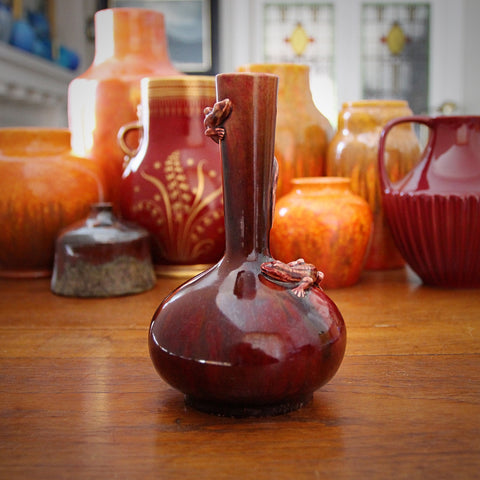This vase, probably English or French, ticks a couple of Nineteenth Century boxes: Asian Style and Darwinian Intrigue. Both of these dynamics were at play in the minds of Late Nineteenth Century Europeans.
First, there was the Western fascination with "Oriental" art and design—especially Asian style as embodied by Chinese ceramics (which 95% of Europeans could not afford). For a few centuries, Western traders had been crossing vast seas, buying and selling with China, Japan and Southeast Asia. Chinese ceramics were an important (and valuable) part of this trading mix. The Chinese had mastered ceramics production techniques which blew the minds of the Europeans (this despite their fairly primitive kilns and other equipment). Red glazes (including oxblood, as shown in the vase above) were the most difficult to manage—for a small variation in temperature, time or chemical glaze composition could scuttle the elusive color. Though Europeans tried to copy Chinese ceramics effects, they just couldn't figure them out—and the Chinese weren't telling their secrets. Throughout the Nineteenth Century, rich Europeans (especially Englishmen) signaled their wealth by accumulating vast collections of valuable Oriental ceramics. It was the status symbol amongst Industrialists and Aristocrats of the Nineteenth Century.
The vase, shown above, also tickles the public's intrigue with evolution, stirred-up with Charles Darwin's 1859 book, On the Origin of Species. In the late Nineteenth Century—in Europe and in America—all things creepy-crawly were used in the decorative arts: butterflies, moths, spiders, snakes, and, yes, lizards—which the vase above incorporates. Even high-end manufacturers, like Cartier or Tiffany Studios, used such creatures in their product designs.
In time, Western ceramicists finally learned how to copy the Chinese ceramics techniques. Nevertheless, true Asian imports still remained very expensive. That's when Western ceramics makers began to produce their own "Oriental" offerings for domestic consumption. These were never authentic, in fact, they were clearly Asian design interpreted though Western eyes. But they provided affordable, exotic style—a chance for someone of modest means to travel vicariously to another, faraway place.
The vase, shown above, incorporates a classic Chinese form (the bottle vase), that formerly-elusive glazing (oxblood), and a creeping reminder of evolution (a pair of sculpted lizards). I am not certain of the maker. My initial reflex was England's Burmantofts (I found the piece in London) or France's Dalpayrat. The wonderful form, with squiggling lizards, intrigued me—as did the earthy, somewhat variegated oxblood glazing. Click on the photo above to learn more about it.
Though our Greenwich Village store is now permanently closed, LEO Design is still alive and well! Please visit our on-line store where we continue to sell Handsome Gifts (www.LEOdesignNYC.com).
We also can be found in Canonsburg, Pennsylvania, at The Antique Center of Strabane (www.antiquecenterofstrabane.com).
Or call to arrange to visit our Pittsburgh showroom (by private appointment only). 917-446-4248


